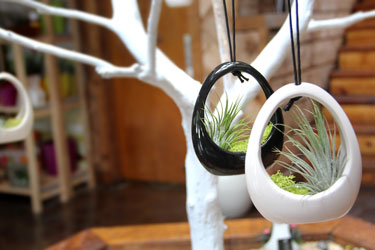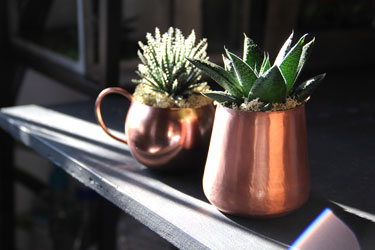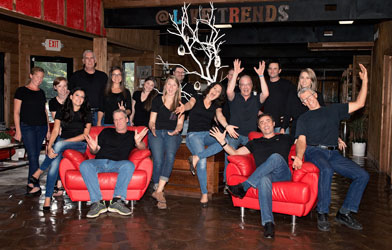11/27/2015
Business by Design
Chris Beytes

After almost 20 years with Hermann Engelmann Greenhouses, including two years as president, Bisser Georgiev launched out on his own to start LiveTrends Design Group, a firm devoted to “blending fashionable design with living nature and simple living.” The 43-year-old native of Bulgaria has always had a passion for art, design and anticipating trends. Here’s why he feels good design is critical enough to have made it his competitive edge.
GrowerTalks: Why the name LiveTrends?
Bisser Georgiev: The principle of LiveTrends—our mission—is to blend fashionable design with living nature and simple living. It took me a while to decide what name could describe all these things. “Live” comes from living plants and “trends” … basically, we follow trends very closely and designs pretty much live on trends. So that’s what it means: LiveTrends Design Group. The “group” part came from collaboration. I love collaborating with my team members, my retailers, my suppliers. I want to see it as a playground more than just a company.
GT: Why do you feel design is important?
BG: Design should be the centerpiece of any kind of business model or strategy for any company in the horticulture business. We have to admit that we all operate in the home décor industry. And if you’re in any kind of décor business, you should be aware that design is the primary driver for success. Some companies are aware of that, some are not.
If you talk to any fashion-driven company in the clothing or furniture industries and ask them, “What is the most important core value of your business?”, they’re going to tell you one thing: design. But if you talk to any horticulture company, they might tell you a variety of things—from plant quality to distribution networks to supply chain management … a variety of things, but design is rarely the core principle value of any strategy. And that’s why to me it is so important. This is our biggest competitive characteristic: design. [Design] defines a product, it defines a collection, it defines how a thing is being enjoyed.
GT: What do we need to know  about design?
about design?
BG: There are many misconceptions about design, but there are three huge ones. The first is that good design only comes at a high price.


This is not true. Historically, it was true, when we look at luxury brands, such as Chanel or whatever. But also look at some of the most successful mass-market companies out there today, such as IKEA, Target, Urban Outfitters, H&M. They have amazing design and very low prices.
The second is that design can only be applied to the packaging of the product in the horticulture business. That’s not true. We work with the most amazing palette of natural colors, textures, thousands of varieties. All of those things can be applied in so many different areas of the actual product, not just in the
packaging.
The last is that retailers and consumers don’t care about design, they only care about low prices. That’s not true. If you ask any retail buyer, from the smallest to the largest, they will tell you the same thing: that innovation is the most important thing they are looking for. And I believe that design is the most important part of innovation.
Pictured: Most of LiveTrends’ products fit the “Easy” and “Cool” categories, such as these hanging tillandsias and the aloe and haworthia in copper. Note the “Moscow mule” cup, one of the trendy bar drinks right now.
In two and a half years, LiveTrends has gone from three to 55 employees. Average age: a youthful 29.
GT: We seem to think that a colored pot and clever tag equate to design. You say it should go beyond that?
BG: Absolutely. That’s the biggest misconception we have about how we can introduce design into horticulture. Everybody thinks, okay, well, give me a pot and it costs a dollar and that is it. The pot is important, but it’s a lot more than this.
If you buy an Apple phone, you don’t really look at the box that it comes with, even if the packaging is beautiful. It’s what it does for you, how it functions … it’s the entire thing. So we should look at the horticultural product in a more holistic way, something that involves every single part of the product, from the actual plant to the soil mix, to the way it’s packaged and presented at retail, how it’s merchandised.
GT: It seems there are three “designers” involved—the breeder, the grower and the retailer—and none of them work together to create a holistic product as you suggest.
BG: That’s the point right there. The lack of collaboration leads to one thing: a lack of inspiration.
GT: So how does your company create inspirational products?
BG: We focus on truly original ideas from the get-go. We collaborate with different people around the world, but our main focus is to be truly innovative in everything we do. And also, the idea is to be highly focused on the design element, making sure it is unique, but also providing affordable living art. And that’s very hard to do. We start first with the consumer’s needs and then work backwards to find the best solutions. That might be better packaging, better varieties or whatever, but we always start with the consumer in mind.
GT: Knowing what’s trendy is obviously an important part of the design process.
BG: Being aware of trends, following trends, is great. But it’s not enough. Because if you follow trends, by the time you launch your product, most likely you’re going to be late. The idea here is to actually anticipate trends before they happen. This is hard. And also very risky.
Good companies implement trends, but the best companies create trends themselves. That is extremely hard to do and also extremely rare to see. By no means are we in this category yet, but this is my
inspiration.
At LiveTrends, we’re working on a 24-month cycle. We’re developing things two years ahead. Finding trends that are projected to be two years ahead is almost impossible. And that’s why we are in the business of anticipating trends instead of following them.
GT: How do you figure out the trends before they’re trends?
BG: That’s very hard and it’s part of our “secret sauce”—the secret formula behind what we do. It’s actually a very comprehensive and complex process with many, many steps that we follow and each step comes with a date and a deadline.
I don’t want to give out the entire recipe, but the main thing is that we work with a lot of external designers and a lot of forecasters, people from all over the world, from Asia to Germany, Denmark, Holland and, of course, the States. It’s not so much about following one single trend company or designer, it is connecting the dots—a little sprinkle of this, a little sprinkle of that, and then you have to have an amazing team of people to actually put it all together.
GT: How can a company become more design oriented?
BG: They have to start thinking differently. They have to start thinking that they are not in the plant production business; they are in the home fashion industry. And when this paradigm shifts, your entire thinking becomes, “What do I need to be aware of? What’s next?” And you’ll put your energy towards that, you’re going to find those facts, those shows, those crazy individuals and companies that you can collaborate with.
GT: Give us a few hints where you see the trends.
BG: Right now, the way I see it, there are three main categories in the plant business: Easy, Structural and Cool. Now, these are more for the indoor plant category; we don’t deal with the outdoor category at all.
The easy category is maintenance-free plants like succulents, air plants and such. Structural plants provide more artistic inspiration with color and texture. This kind of plant reminds us of great architectural works, works of art. Such plants could be things like haworthia, aloes and many others. And the cool category is defined not so much by the plants, but by the application. These are things that you can brag about online on social media. It’s not about the plant so much as how it is used or displayed. This category is where LiveTrends plays so well, from our magnetized pots to cool hanging pendants … different ways to display and enjoy plants.
GT: Aren’t Millennials supposedly demanding more than just pretty looks from plants?
BG: The next generation demands good aesthetics, they demand easy, they demand simple. But they also demand inspiration. And the inspirational piece, to me, it much more important than anything else. Very often, people ask me, “Hey, how about educating the consumers about the benefits of plants or how to garden with those plants?” And I always say that inspiration is a lot more interesting for that 20-year-old than anything else. Just look around, look at Pinterest, look at Etsy, look at what’s going online and how many people are discussing the benefits of houseplants cleaning the air versus discussing how many different inspiring ways there are to create centerpieces for their dining tables or terrariums or windowsills. Just do a basic search and see how many discussion topics and blogs you find for one topic versus the other.
GT: Do you see the same opportunities for design in garden plants?
BG: Of course. That is the biggest category out there, so much larger than anything indoor. I think there’s a huge potential. Now, what is that potential? I don’t know because I don’t focus on it. But there are some great players out there doing a great job on genetics, a great job on variety selection and supply chain management, so they can do an amazing job on design—and actually some of them already do.
GT: But it’s a wide-open category, and one you’re not involved in, so they don’t have to compete with you.
BG: Absolutely. And, speaking again of collaboration, I’d be happy to help them!
GT